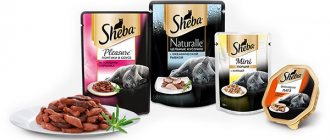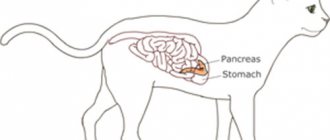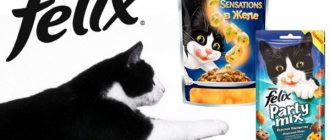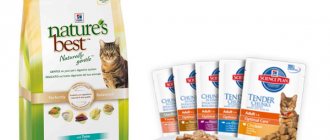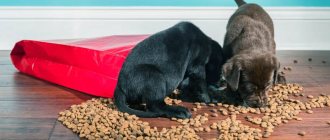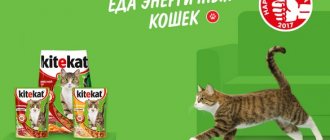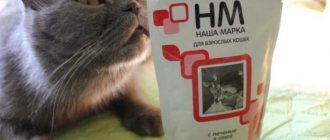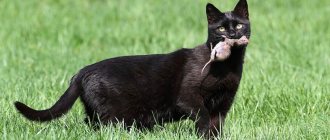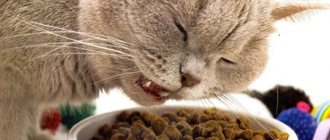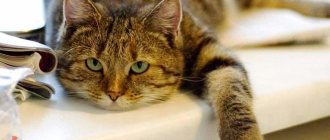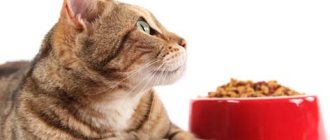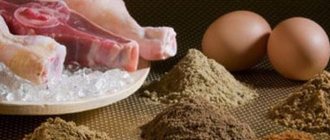The difference between wet food and dry food
Wet cat food seems to be a convenient choice for owners: it is readily eaten by cats, well-balanced and healthy.
Liquid cat food with a high meat content is an excellent option either as a base or as a supplement. If the cat does not like dry food, then mixing it with wet food is quite possible. The main benefit of wet food is that it contains water, which is an important component in keeping your cat healthy. This is especially important in the summer, as well as for pets with kidney or bladder problems.
Eating a balanced diet for your pet is important for its health.
Important! The basis for good health and well-being of a pet is a properly selected diet.
Wet food has many benefits for both cats and their owners. Among them:
- a large amount of protein and fats, which are necessary for the health of the pet;
- low percentage of carbohydrates, which does not contribute to excess weight gain;
- the composition includes water (75%), which is beneficial for the pet, especially for those who drink little liquid. Moisture in food prevents gastrointestinal problems;
- ability to quickly saturate a cat due to its high protein content. The animal is not prone to overeating;
- ease of use: open it, put it in a bowl and you're done.
Among the most significant disadvantages of wet food are:
- is not able to protect your pet from the formation of tartar and gum disease. When using only this type of food, it is necessary to separately take care of your pet’s teeth with other means;
- Storage of open packages lasts a short time. Opened canned food only lasts for a couple of days even in the refrigerator;
- more expensive than regular dry.
Wet food is convenient for owners
Wet cat food comes in many forms. It differs both in packaging and consistency. In pet stores you can find products packaged in jars or bags. The former have different capacities: small cans (70–100 g) to large sizes and more economical options (200–400 g). The packages have a small volume, from 85 to 100 g.
The consistency of wet food is much more varied than the dry version. In jars you can find carefully chopped pieces of meat or fish. Another type is reminiscent of canned food. You can find jars and bags of whole pieces of meat in sauce or jelly.
Important! The best option for wet food is in the form of pate. It is soft and easy to serve the animal.
Canned food is the most popular wet type of food for cats. In this case, pieces of meat or fish are visible and the quality of the food can be assessed at first glance. Their composition can contain up to 90% meat.
Dry food has a number of advantages:
- saving money. It is financially more profitable to purchase dry food in large packages;
- saving the owner's time. Simply pouring a handful of food into a bowl is enough;
- with good quality, you do not need to follow a diet;
- quality food is well balanced and rich in nutrients. It is worth choosing a trusted manufacturer.
Disadvantages of dry options:
- little moisture leads to problems with the urinary system, especially if the animal consumes little water;
- harms cats' teeth, contrary to the existing myth that dry food cleans teeth;
- if the quality of the food is low, it contains a lot of carbohydrates, which can cause a jump in blood sugar and lead to an imbalance in metabolic processes;
- cats getting used to low-quality dry food options due to aromatic additives.
Dry food has its advantages and disadvantages
Which food should you choose?
The absence of major differences in composition practically eliminates the need to choose between wet and dry cat food, but a number of other features can be decisive in certain situations. For convenience, we will list them in the advantages of each type, so that it is easier for you to be guided by specific points.
Pros of wet food:
- more attractive - cats eat it with great pleasure,
- portioned packaging - manufacturers clearly indicate how many small sealed packs (spiders) or jars a cat of a certain age needs per day.
Pros of dry granules:
- Easier to store - the packaging can be carefully closed and stored in a closet. When used this way, the granules retain their taste and properties for weeks. After opening, wet food can only be stored in the refrigerator, and no more than a day.
- You can pour it into a bowl for the whole day. Cats usually do not eat the entire portion at once, preferring to eat it gradually. In the open air, the granules “dissipate” slowly - if there is enough of them, they will be enough for the entire period of your absence during the working day. Wet food dries out quickly and spoils in the heat, so your pet runs the risk of going hungry.
- Feeding a cat dry food is cheaper - when buying wet food, in the literal sense of the word, you have to overpay for water.
And lastly, we decided not to include crunchy food among the benefits. We are talking about brushing teeth: it is believed that when biting granules, the enamel is cleaned and tartar is removed. In fact, this is not entirely true: the pieces are quite soft and their contact with the tooth surface lasts only a few moments. Of course, wet food does an even worse job in this regard, but you can only truly clean your teeth with treats specially designed for this purpose.
Is it possible to feed a cat both dry and wet food?
Is it possible to feed a cat dog food - wet or dry and what is the difference?
As a rule, the healthiest option is still natural food, which includes a balanced and suitable diet for the cat. When there is absolutely no time to cook, the question arises whether it is possible to combine dry food and natural food for cats. Answer: it is possible, but the quality of dry (wet) food must be high. It is necessary to purchase premium and holistic food.
Although it is possible to mix dry and wet food together, this is not recommended as the cat's digestive system gets used to a certain type of food, releasing the corresponding enzymes. And when mixing different options, he may have problems with the gastrointestinal tract. However, mixed meals at home are acceptable, but not often and at different meals. In this case, it is better to combine food from the same manufacturer.
Mixing food is possible, but it should be done wisely
Is it possible to mix different manufacturers?
Those who believe that it is possible to mix cat food from different manufacturers are mistaken. The reasons for this are:
- different balance;
- different calorie content.
Each manufacturer achieves feed balance in its own way, which is reflected in their composition. The same level of protein is obtained from both low-quality plant elements and high-quality animal raw materials.
By mixing food, it is impossible to improve the quality of food that is inferior in composition. In such a situation, even the best food will not be beneficial. There will be an imbalance that every manufacturer strives for in order for the product to be considered a complete nutrition. It turns out that there will be more of some substances, less of others, which is fraught with the appearance of various diseases for the animal.
Important! Mixing food from different manufacturers will negate the results of balance, and your pet’s nutrition will not be complete.
Another important reason why you should not mix food from different manufacturers is calorie content. For each diet, different manufacturers have their own calorie content. For this reason, consumption rates for different feeds are different.
When mixing food of different production, it turns out that the diet has not just an arbitrary composition, but also an unknown energy value and calorie content. This may result in overfeeding your pet or, conversely, a calorie deficit. This will be immediately noticeable in the pet’s changed behavior. Excess is fraught with obesity, which may not be noticed immediately.
You can only mix feed from one manufacturer
Can it be mixed with natural food?
The reasons mentioned above also negatively affect the processes of mixing ready-made feed with natural food. Although this practice is very common among most owners. It appears that breeders are trying to diversify their pet's diet, but in reality they are only increasing the risk of eating disorders, allergies and intolerances.
The opinion that dry food is uniform in composition is erroneous. In them, all the elements are balanced and accessible. If natural food is added to dry food, the number of ingredients increases sharply, resulting in a kind of cocktail that is rich in the composition of substances. The pet's stomach needs to digest such a diet, which becomes a rather complex process.
Mixing with natural food is acceptable, but at different meals
Dry cat food storage container
The cat eats little, the life of the opened product is short, so buy a small container for storing cat food. Calculate the volume so that the whole pack can be placed in it, and not slowly poured out.
Before buying a cat food storage container, pay attention to the following points:
- Material. Give preference to products made from food-grade tin. If you want a plastic box, make sure the material is good quality, otherwise it will transfer toxins to the granules.
- Form. Take a rectangular or square box. Round or oval takes up a lot of useful space.
- Dimensions. When buying a container, focus not only on the volume of food packaging. Consider the place where you will store the product and select the dimensions, paying attention to the width, depth, and height of the space.
- Lid. May or may not be attached to the container. But it must close tightly, ensuring tightness. Some lids have a special window that can be easily pulled aside, pour out food and close.
Buy containers, bowls, dry and wet food only in veterinary pharmacies and pet stores. Avoid bazaars. The goods sold there rarely have certificates and are stored in poor conditions.
Feeding standards
All packages of ready-made food indicate the dosage of the daily portion in grams, depending on the age and weight of the animal.
Is it possible to feed a dog dry and natural food at the same time?
The amount of wet food is considered normal at a value of 5% of the animal’s weight. That is, if a pet weighs 5 kg, then 175 g of wet food per day is enough for him.
Note! A cat with a calm lifestyle needs 70 ml of water per 1 kg of weight per day, and with an active lifestyle - 85 ml per 1 kg of weight. This is approximately 4-6 tbsp. spoons of water.
For adult cats, the daily intake of dry food is:
- weight up to 3 kg - 25 g;
- weight from 3 to 4 kg - 40 g;
- weight from 4 to 5 kg - 55 g;
- weight over 5 kg - 12 g per 1 kg of weight.
For a kitten this norm looks like this:
- weight up to 2 kg - 35 g;
- weight from 2 to 3 kg - 50 g;
- weight from 3 to 4 kg - 70 g.
A pregnant cat needs 55 g of dry food per day.
For large breed cats, the calculation is based on the rule: 12 g per 1 kg of animal weight.
For older animals, the norm is slightly reduced by 10-20%.
For active cats, the feeding schedule is free in large portions.
For sterilized cats, food is given 2 times a day in small portions, as they are prone to obesity.
Feeding standards for cats should be followed
In one bowl or separately
There is no single recommendation on this matter from veterinarians and well-known manufacturers. Some believe that it is possible to mix different types of food in one bowl. Others insist that time should pass between the intake of dry and wet food. Since no research has been conducted on this issue, there is no clear answer.
What food is best to feed a cat: advice from veterinarians
Most recommendations highlight the following points:
- separation of food makes it possible to accurately track how much and what was given to the pet in terms of volume, composition, how much the animal eats, what can be mixed and what cannot;
- if you alternate food, it is easier to track the animal’s reaction to one or another type of food: what caused the allergy, indigestion and other undesirable effects;
- mixing feed leads to spoilage of the dish and loss of taste characteristics much faster.
Important! It is worth trying a mixed feeding option first, then separate feeding. You need to track which option was more preferable for the cat and make a choice in its favor.
Is it possible to alternate dry food and natural food?
Often, owners prefer to use a mixed type of feeding, giving the animal a ready-made diet in the morning and natural food in the evening.
This solution has a number of features:
- Dry granules swell in the digestive system and have time to be absorbed;
- Natural foods take much longer to digest, so experts advise feeding natural foods in the evening. This way, more than 8 hours will pass between meals and all nutrients will be completely fermented;
- Consultation with a veterinarian will allow you to choose the optimal type of mixed feeding. The granules contain a sufficient amount of cereals. Therefore, you should not prepare porridge with meat for your pet’s evening feeding. You should give preference to fish or meat products in combination with vegetables or fruits; offer your dog eggs or cottage cheese;
This is important: those owners who have made a choice in favor of premium class diets or the Holistic category should approach the process of mixed feeding with extreme caution. These products contain the optimal amount of meat and a balanced content of fats and carbohydrates.
You might find our article useful: Which is better: Dry dog food or natural? All pros and cons
Additional introduction of a large amount of protein food into the daily menu will create additional stress on the kidneys and can cause an allergic reaction to protein. In this case, offer your pet fermented milk products, as well as a mixture of fruits and vegetables.
Veterinarians remind us that the use of mixed feeding is only possible for healthy dogs that do not have any chronic diseases.
An important point is that the duration of mixed nutrition should not exceed several weeks. That is, you should not constantly feed your pet according to this scheme.
Time to keep food in bowl
For wet food, opened packaging should be kept in the refrigerator for no more than 2-3 days. In this case, the food should be transferred to a glass bowl.
It is advisable to store the opened food packaging in the refrigerator, hermetically sealed. Air access contributes to the oxidation of components and loss of their value.
Important! If wet food is in your cat's bowl, you should not leave it all day: it may spoil or dry out, especially if the room is hot.
The shelf life of dry food is usually indicated on the packaging. But it concerns exclusively the hermetically sealed version. However, an open pack of dry food can only be stored for 1.5-2 months. The fact is that the fats in the food are oxidized, which can cause gastrointestinal upset in the pet.
It is better not to leave food in a bowl for a long time
How to feed
When choosing cat food - dry or wet - you should be guided by the composition. Wet food for cats, the best in composition, should contain primarily meat: the more of it, the better the quality of the food and the more effective it will be for the health of the pet.
Proper nutrition is the key to your pet’s health
Among the elements of natural products you need to add:
- vegetables. It is a valuable source of vitamins and microelements, as well as fiber. They support digestion and increase the nutritional value of food;
- eggs. In some cat foods, eggs are an additional source of protein. In addition to this, they also contain vitamin A, D, iron and polyunsaturated fatty acids;
- taurine is an amino acid found in meat that is essential for keeping your cat healthy. Promotes the proper functioning of the heart and digestive system. In addition, it plays an important role in building immunity and the functioning of the animal’s nervous system;
- vitamins, minerals, trace elements have a beneficial effect on the condition of the cat’s skin, coat and general well-being.
When planning your cat's or kitten's diet, it is important to consider that a good wet food should not contain cereal, sugar, preservatives or artificial colors and flavors. The simple composition and many useful nutrients will allow the cat to live a long time and not get sick.
Is it possible to combine industrial cat food with “homemade” food?
Hello, dear readers!
Today I received this question:
Good evening! We feed the cat Royal Canin food, sometimes we try to diversify the diet with regular food, for example, porridge with meat. The cat eats everything and has had no health problems yet. But still, I would like to consult with you whether the food can really be called a balanced diet, whether it is worth giving the cat something other than food, and what is better to give. Natalia.
I will try to answer it and hundreds of other similar questions.
What does a cat eat in “natural conditions”
I'll start with some questions to think about. What does a cat eat in nature? How much does the chemical composition of a frog differ from the chemical composition of a mouse, and how much does all this together differ from the composition of a bird?
You will be surprised how small the differences are. A cat is a predator, and according to the biological classification, it is an obligate predator. That is, a cat can only take some essential amino acids from food, since it does not synthesize them itself. Its intestines are shorter than those of a dog, and digestion is very active. Therefore, the composition of what she eats is very important to her.
It is not the “appearance” that is important, but the composition of the feed
Industrial food was created in order to enable animal owners to feed their cat without unnecessary problems something that is similar to its natural prey in terms of the ratio of the chemical components of the food.
The higher the level of industrial food, the closer its composition is to that of a mouse or bird.
The same composition can be made at home if, in addition to meat, you take offal, sources of calcium (in a mouse or bird these are bones, calcium from which dissolves in the acidic environment of the stomach), a source of taurine and other essential amino acids and vitamins (in “ In natural food, this is the intestine of a freshly killed victim with all its contents) and a fermented plant component - fiber (in nature - from the same intestine of the victim, full of plant food). If you take all this in the required proportion, you will get a completely complete food.
You may ask, what about in the villages, who ever balanced the food there? So in the villages, cats were free to range and mice, rats, birds and frogs were their main food. And all sorts of “sour cream” or “milk” were just a treat and an additional source of calories for a cat leading an active lifestyle.
Sour cream and milk have always been a treat for the village cat. And in the villages cats were never fed meat; at best, “offal”, i.e. offal, and then also as a delicacy. The cat was supposed to catch (and, accordingly, eat) mice.
What problems does a feeding disorder lead to?
But this is not the only important thing. In nature, cat food has not only a constant protein-fat-carbohydrate ratio, but also a constant level of moisture. The animal’s body “adapts” to it from the very beginning of the transition from milk nutrition to carnivore nutrition. The basic “adjustment” becomes constant depending on the type of feeding (dry or wet) or on the time at which the animal consumes a particular food (for example, morning and evening - wet, and day and night - dry). A more subtle “adjustment” occurs on the principle of feedback between the stomach and intestines through a system of local hormones circulating between them.
If the moisture content of the feed changes dramatically, then the composition of the gastric juice should also change dramatically. So, when switching to dry food, gastric juice becomes more liquid, and the concentration of hydrochloric acid and digestive enzymes in it becomes lower than when eating wet food (it doesn’t matter whether natural, industrial or “homemade”). The same applies to pancreatic enzymes, as well as the composition of bile, which is produced by the liver.
Constant “jumps” between the moisture level of different feeds and different feed compositions disrupt the functioning of the enzyme system of the stomach, pancreas and liver, and enzyme deficiency leads to impaired digestion of feed and dysbiosis in the large intestine.
A sharp change in the humidity of the feed disrupts the ratio of water and enzymes in the gastric juice, which is optimal for digestion. This leads to severe overload of the digestive tract and chronic diseases of the cat.
The result is problems with the liver, pancreas, and other organs and systems of the body. The most unpleasant thing is that it is not possible to identify the problem by clinical signs at an early stage, since the cat’s body tries to maintain shaken homeostasis (constancy of the body’s internal environment) by mobilizing internal reserves, which further “swings” the shaken balance. And this condition can last for several years.
Some deviations can be detected using tests. But it is much better not to bring it to the stage at which the problems become visible to the doctor. Because this will indicate that the cat’s body can no longer compensate for the problems that have arisen. Do you want this?
What should a cat owner do to keep her healthy?
And now I want to return again to where we began to consider the problem. To the laws of nature. You can go against nature, or you can take a closer look at how natural processes flow and not try to “reinvent the wheel.” And in nature we see the constancy of a complete diet.
But you shouldn’t “go too far” here either. You are unlikely to be able to feed a completely domestic cat living in a city apartment with live mice or birds. All that remains is to either make a complete “homemade” analogue of “natural food”, or use ready-made industrial food, carefully selecting the appropriate one from the huge offer.
How to feed a cat in a city apartment
Most people, and I am no exception, choose a simpler option - industrial feed. And in order for its use to help your pet maintain health and activity for many years, you need to follow a few simple rules:
• Never feed more than what the manufacturer recommends. The ideal option is the norm “from the manufacturer” minus 5-10%. • Feed food to the cat in fractions, adding parts of the daily portion little by little throughout the day. And between feedings it is very advisable to play with the cat. This is similar to what happens in nature, when before “swallowing” (eating the next victim), a cat first has to “stomp” (that is, hunt). • Wet food from the refrigerator must be warmed to body temperature - the cat only eats fresh prey. There are no refrigerators in nature. Even in winter the victim does not have time to cool down. • Monitor the weight of your furry pet and if it increases, urgently take measures to bring the cat’s weight under control. • Monitor the condition of the cat's skin and coat to understand whether it is worth changing food or if everything is fine. • Take tests periodically to be sure of the correct choice, because There is no ideal industrial feed. There are only more or less suitable ones. • Do not combine feeding a cat with industrial and “homemade” diets, because it is unlikely that it will be possible to achieve a similar composition of such different diets, and unnecessary tests are hardly needed for a cat’s gastrointestinal tract, which is not adapted to this. • Change from one diet to another (any to any, including industrial to industrial) ONLY gradually, adding part of the new diet to the old one. And periodically (no more than once every 6-9 months) I would advise changing one industrial food for another to those whose cats are losing interest in their usual diet, or to those who think that the cat is still not getting enough of something in the food .
Following these simple rules, monitoring and understanding what they are based on will allow you to keep your cat healthy.
Is it possible to keep a domestic cat healthy by eating a “natural diet”? Of course you can! But doing this for a working city dweller is much more difficult. We will look at the details in the next article in the Feeding series.
Subscribe to our news and learn more useful details about the life and health of your pets.
Natalya Troshina, veterinarian (DVM)
